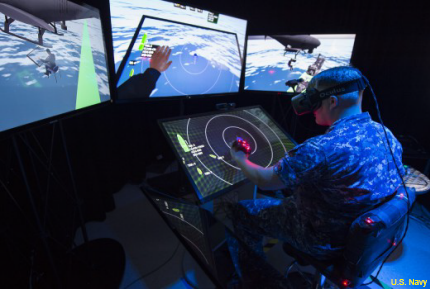ONR taking virtual training to the next level
The BEMR Lab in San Diego is developing new "mixed reality" capabilities to improve training on a variety of platforms.

The BEMR Lab is developing low-cost, cutting edge mixed reality tools.
Navy researchers are adding a new level to their virtual training scenarios, combining virtual and augmented reality systems into a “mixed reality” system that could improve training for a variety of setting and systems while cutting the costs of training.
Sponsored by the Office of Naval Research, the BEMR Lab (for Battlespace Exploitation of Mixed Reality) in San Diego gives service people a combination of familiar, off-the-shelf technologies, such as Oculus Rift goggles, with practical training that can be applied in real-world scenarios.
“The BEMR Lab is a constellation of technologies in augmented and virtual reality,” Karl Van Orden, senior technologist at the BEMR Lab, said in a release. “It’s a place where we can explore how to exploit those technologies in our warfighting systems.”
Virtual reality systems put users into a self-contained, computer-generated world. Augmented reality adds virtual elements to physical settings. (One example would be ONR’s Augmented Immersive Team Trainer (AITT) system, which superimposes objects such as vehicles on a physical training ground.)
Combining virtual and augmented reality creates Mixed Reality, or MxR, which allows a user to move back and forth between the two worlds. “What mixed reality is all about is immersion—you want to get the warfighter feeling like he’s really in the space,” said Heidi Buck, BEMR Lab lead. The program is being developed at the Space and Naval Warfare Systems Center-Pacific.
As researchers point out in the above video, an MxR system could allow a sailor walk the decks of a ship, getting to know its details before ever arriving at the actual vessel. Or allow a Marine to get to know a town before going there.
This kind of training also could be used with a variety of weapons systems, something the military has had success with using other simulations—aMarine Corps study released earlier this year showed that tank crews trained on simulators saw improved scores when they got to live-fire exercises.
Virtual training also can cut costs by saving trainees from having to travel to a specific site and by allowing participants from multiple sites around the country—or the world—to take part in a single exercise. And, of course, if it involves weapons systems, they can save on the substantial costs of munitions.
The military has been moving toward greater use of virtual and simulated training in recent years, particularly focusing on immersive technologies that allow teams at multiple locations to take part in joint exercises. Although whether to use virtualized systems for training currently is the choice of commanders, some military officials have discussed the idea of making the mandatory.




